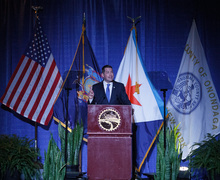Turnovers haven’t hurt Syracuse yet, but they may soon
TJ Shaw | Staff Photographer
Syracuse's Gabrielle Cooper said she expects some of the early season turnover issues to "smooth out."
Digna Strautmane put her hands on her knees and flashed a grin. She had messed up but it didn’t matter. Strautmane maintained her balance, and her toes remained free of the baseline after she lunged forward for a loose ball that slipped through her hands. She didn’t fret: Syracuse was very much in charge of the game.
In an eventual 98-55 win against Towson on Dec. 2, Syracuse threw the ball all over — high above each other’s heads, out of bounds and right to a defender in the post. Syracuse University head coach Quentin Hillsman said there are no “good turnovers,” and the Orange will continue to workshop their ball-security going forward. But what Strautmane might’ve realized has been the story for Syracuse’s season: So far, it hasn’t affected them.
Syracuse (7-2) has had consistent turnover problems in wins, in losses, blowouts and close games. A manifestation of the Orange’s fast-paced play, they’ve turned the ball over 20-plus times in four different games this season and set a season-high of 24 twice. But none have had an effect on SU’s play this season. Syracuse hasn’t lost a game when it turned the ball over more than 20 times, and its two losses produced its second (12) and third (15) lowest turnover totals of the year.
“That’s a lot about being young and not playing together,” Hillsman said. “The more we play together, the more we practice, the better we’ll be in that department.”
At media day prior to the season, SU associate head coach Vonn Read said that Syracuse’s offense might go through changes. It wasn’t going to slow down, though. This season, the Orange top the Atlantic Coast Conference with 66.3 field goal attempts per game, 4.1 more than the next highest team.
In the offseason, as SU added piece after piece to its roster — three French recruits and Ohio State transfer guard Kiara Lewis became eligible to play, and Syracuse added the No. 11 recruit in the country in Emily Engstler — preventing turnovers remained a key emphasis. Tiana Mangakahia, SU’s starting guard who averaged 5.7 turnovers per game last season, wanted to limit hers. With new players that add an element of Syracuse in the post, the Orange looked to work the ball inside more.
“We want to be able to utilize the skill and the depth that we have,” Read said. “But you have to recognize the kind of players you have and kind of make adjustments.”
Syracuse has players who can shoot from the perimeter. They can slash inside. They can battle in the post. But players’ awareness of the Orange’s versatility is perhaps their biggest weakness, Hillsman said. He said that SU’s most pressing struggle has been their tendency to overpass, resulting in turnovers. Hillsman calls them “selfish” turnovers. It’s not about passing up shots to conserve a shooting percentage, but rather a tendency to be too unselfish that sometimes leads SU into trouble.
Hillsman keeps showing it on film. He keeps yelling it from the sideline. If you have an open shot — one that you’re within your range to make — take it.
“I think (it’s) us trying to make the extra pass,” Lewis said. “It’s not really a bad thing.”

Laura Angle | Digital Design Editor
Against DePaul Nov. 24, Engstler, who has been lauded by many on SU for her ability to pass the ball, turned it over multiple times passing up open shots on the perimeter to squeeze the ball inside. Hillsman wants Engstler and her teammates to fire when they’re open. Sometimes being too unselfish becomes selfish, he said.
Syracuse has gotten caught overpassing multiple times this year. Point guards have fired outlet passes too early, and players passed up open shots in favor of an extra pass to a shooter who has already cut inside.
“The freshman coming in, they’re going to have turnovers to get into the flow of the game and into college basketball,” Mangakahia said. “It’s them getting used to playing here.”
Despite the problems, Syracuse hasn’t felt the consequences. It’s something it needs to work on, but as long as the shot attempts are there, Lewis said, there’s little issue. But when a game is close, junior Gabrielle Cooper said, the turnovers will begin to show. So, Syracuse looks to limit them.
“We’re playing really young, we’re playing fast,” Cooper said. “We’re still getting the groove. So, it’s going to smooth out.”
Published on December 4, 2018 at 9:53 pm
Contact Michael: mmcclear@syr.edu | @MikeJMcCleary






